Giant Quartz Veins of the Bundelkhand Craton, Indian Shield: New Geological Data and U-Th-Pb Age
Abstract
:1. Introduction
2. Geology of the Bundelkhand Craton and Surrounding Proterozoic Basins
3. Methods
4. Geology of Quartz Veins
5. Results of Isotope Dating
6. Discussion
7. Main Conclusions
- New geological data proved that the giant quartz veins of the Bundelkhand Craton cut the Paleoproterozoic (2150–1800 Ma) sediments of the Bijawar Group and are overlain by Proterozoic (1670–1030 Ma) sediments at the base of the Upper Vindhyan Supergroup. Therefore, the relative geological age of the quartz veins can thus be inferred in between.
- U-Th-Pb dating of zircon grains from the quartz vein is indicate starting hydrothermal event for their formation at 1866 ± 12 Ma. This data is consistent with the relative geological age of the quartz veins as discussed above.
- The formation of the swarm of giant quartz veins was associated with the uplifting of the Bundelkhand Craton during 1.9–1.8 Ga ago, which seems to have been triggered by compression caused by collision processes at the western flank of the Columbia Supercontinent on one side and plume activity on the other.
Author Contributions
Funding
Data Availability Statement
Acknowledgments
Conflicts of Interest
References
- Bons, P.D.; Elburg, M.A.; Gomez-Rivas, E. A review of the formation of tectonic veins and their microstructures. J. Struct. Geol. 2012, 43, 33–62. [Google Scholar] [CrossRef]
- Pati, J.K.; Patel, S.C.; Pruseth, K.L.; Malviya, V.P.; Arima, M.; Raju, S.; Pati, P.; Prakash, K. Geology and geochemistry of giant quartz veins from the Bundelkhand Craton, central India and their implications. J. Earth Syst. Sci. 2007, 116, 497–510. [Google Scholar] [CrossRef]
- Ramakrishnan, M.; Vaidyanadhan, R. Geology of India; Geological Society of India Publications: Bangalore, India, 2010; Volume 1, 556p. [Google Scholar]
- Pati, J.K.; Raju, S.; Pruseth, K.L.; Magngain, V.D.; Shankar, R. Gold mineralization in parts of Bundelkhand Granitoid Complex (BGC). J. Geol. Soc. India 1997, 50, 601–606. [Google Scholar]
- Pati, J.K. Evolution of Bundelkhand Craton. Episodes 2020, 43, 69–87. [Google Scholar] [CrossRef] [Green Version]
- Roy, A.B.; Purohit, R. Indian Shield: Precambrian Evolution and Phanerozoic Reconstitution; Elsevier Inc.: Cambridge, MA, USA, 2018. [Google Scholar]
- Jain, A.K.; Banerjee, D.M.; Kale, V.S. Tectonics of the Indian Subcontinent; Springer Nature: Cham, Switzerland, 2020; 576p. [Google Scholar]
- Singh, P.K.; Verma, S.K.; Singh, V.K.; Moreno, J.A.; Oliveira, E.P.; Li, X.; Malviya, V.P.; Prakash, D. Geochronology and petrogenesis of the TTG gneisses and granitoids from the Central Bundelkhand granite-greenstone terrane, Bundelkhand Craton, India: Implications for Archean crustal evolution and cratonization. Precambrian Res. 2021, 359, 106210. [Google Scholar] [CrossRef]
- Joshi, K.B.; Bhattacharjee, J.; Rai GHalla, J.; Kurhilla, M.; Heilimo, E.; Ahmad, T.; Whitehouse, M. The diversification of granitoids and plate tectonic implications at the Archaean–Proterozoic boundary in the Bundelkhand Craton, Central India. In Crust–Mantle Interactions and Granitoid Diversification: Insights from Archaean Cratons; Special Publications 449; Halla, J., Whitehouse, M.J., Ahmad, T., Bagai, Z., Eds.; Geological Society: London, UK, 2017; pp. 123–157. [Google Scholar]
- Kaur, P.; Zeh, A.; Chaudhri, N.; Eliyas, N. Unravelling the record of Archaean crustal evolution of the Bundelkhand Craton, northern India using U-Pb zircon–monazite ages, Lu–Hf isotope systematics, and whole-rock geochemistry of granitoids. Precambrian Res. 2016, 281, 384–413. [Google Scholar] [CrossRef]
- Kaur, P.; Zeh, A.; Chaudhri, N. Characterization and U-Pb-Hf isotope record of the 3.55Ga felsic crust from the Bundelkhand Craton, northern India. Precambrian Res. 2014, 255, 236–244. [Google Scholar] [CrossRef]
- Malviya, V.P.; Arima, M.; Pati, J.K.; Kaneko, Y. Petrology and geochemistry of metamorphosed basaltic pillow lava and basaltic komatiite in the Mauranipur area: Subduction related volcanism in the Archean Bundelkhand craton, Central India. J. Miner. Petrol. Sci. 2006, 101, 199–217. [Google Scholar] [CrossRef] [Green Version]
- Mondal, M.E.A.; Goswami, J.N.; Deomurari, M.P.; Sharma, K.K. Ion microprobe 207Pb/206Pb ages of zircons from the Bundelkhand massif, northern India: Implications for crustal evolution of the Bundelkhand-Aravalli protocontinent. Precambrian Res. 2002, 117, 85–100. [Google Scholar] [CrossRef]
- Saha, L.; Frei, D.; Gerdes, A.; Pati, J.K.; Sarkar, S.; Patole, V.; Bhandari, A.; Nasipuri, P. Crustal geodynamics from the Archaean Bundelkhand Craton, India: Constraints from zircon U-Pb–Hf isotope studies. Geol. Mag. 2016, 153, 79–192. [Google Scholar] [CrossRef]
- Singh, V.K.; Slabunov, A. The Central Bundelkhand Archaean greenstone complex, Bundelkhand Craton, Central India: Geology, composition, and geochronology of supracrustal rocks. Int. Geol. Rev. 2015, 57, 1349–1364. [Google Scholar] [CrossRef]
- Singh, P.K.; Verma, S.K.; Moreno, J.A.; Singh, V.K.; Malviya, P.K.; Oliveira, E.P.; Mishra, S.; Arima, M. Geochemistry and Sm-Nd isotope systematics of metabasalts from the Babina and Mauranipur greenstone belts, Bundelkhand craton: Implications for tectonic setting and Paleoarchean mantle evolution. Lithos 2019, 330–331, 90–107. [Google Scholar] [CrossRef]
- Singh, P.K.; Verma, S.K.; Singh, V.K.; Moreno, J.A.; Oliveira, E.P.; Mehta, P. Geochemistry and petrogenesis of sanukitoids and high-K anatectic granites from the Bundelkhand craton: Implications for the late-Archean crustal evolution. J. Asian Earth Sci. 2019, 174, 263–282. [Google Scholar] [CrossRef]
- Singh, V.K.; Verma, S.K.; Singh, P.K.; Slabunov, A.I.; Mishra, S.; Chaudhary, N. Archean crustal evolution of the Bundelkhand Craton: Evidence from granitoid magmatism. In Archean Granitoids of India: Windows into Early Earth Tectonics; Special Publications 489; The Geological Society: London, UK, 2020; pp. 235–259. [Google Scholar]
- Singh, V.K.; Slabunov, A.I.; Nesterova, N.S.; Singh, M.M.; Bhatt, S.C. Tectonostratigraphic terranes of the Bundelkhand Craton (Indian Shield). In Geological and Geo-Environmental Processes on Earth; Shandilya, A.K., Singh, V.K., Bhatt, S.C., Dubey, C.S., Eds.; Springer Natural Hazards: Singapore, 2021; pp. 155–164. [Google Scholar]
- Slabunov, A.; Singh, V.K.; Joshi, K.B.; Li, X. Paleoarchean zircons from quartzite of South Bundelkhand Supracrustal Complex: Origin and implications for crustal evolution in Bundelkhand Craton, Central India. Curr. Sci. 2017, 112, 794–801. [Google Scholar] [CrossRef]
- Slabunov, A.; Egorova, S.; Singh, V.K.; Svetov, S.; Kumar, S. Archean mafic-ultramafic Ikauna layered intrusion, Bundelkhand craton, India: Petrography and geochemistry. Arch. Anthropol. Open Acc. 2018, 3 (Suppl. 2), 49–55. [Google Scholar]
- Slabunov, A.I.; Singh, V.K. Meso–Neoarchaean crustal evolution of the Bundelkhand Craton, Indian Shield: New data from greenstone belts. Int. Geol. Rev. 2019, 61, 1409–1428. [Google Scholar] [CrossRef]
- Slabunov, A.I.; Singh, V.K. The new tectonic division of the Bundelkhand Craton Indian Shield. In Transactions of A. Fersman Scientific Session of Geological Institute, Kola Research Centre; RAS: Apatity, Russia, 2019; Volume 16, pp. 521–524. [Google Scholar]
- Verma, S.K.; Verma, S.P.; Oliveira, E.P.; Singh, V.K.; More, J.A. LA-SF-ICP-MS zircon U-Pb geochronology of granitic rocks from the central Bundelkhand greenstone complex, Bundelkhand craton, India. J. Asian Earth Sci. 2016, 118, 125–137. [Google Scholar] [CrossRef]
- Saha, L.; Pant, N.C.; Pati, J.K.; Upadhyay, D.; Berndt, J.; Bhattacharya, A.; Satynarayanan, M. Neoarchean high-pressure margarite–phengitic muscovite–chlorite corona mantled corundum in quartz-free high-Mg, Al phlogopite–chlorite schists from the Bundelkhand craton, north central India. Contrib. Miner. Petrol. 2011, 161, 511–530. [Google Scholar] [CrossRef]
- Nasipuri, P.; Saha, L.; Hangqiang, X.; Pati, J.K.; Satyanaryanan, M.; Sarkar, S.; Bhandari, A.; Gaur, Y. Paleoarchean crustal evolution of the Bundelkhand Craton, north Central India. In Earth’s Oldest Rocks, 2nd ed.; Van Kranendonk, M.J., Bennett, V.C., Hoffmann, J.E., Eds.; Elsevier: Amsterdam, The Netherlands, 2019; pp. 793–817. [Google Scholar]
- Sibelev, O.S.; Slabunov, A.I.; Mishra, S.; Singh, V.K. Metamorphism of the Central Bundelkhand Greenstone Complex, Indian Shield: Mineral Compositions, Paragenesis’s, and P–T Path. Petrology 2021, 29, 404–438. [Google Scholar] [CrossRef]
- Sibelev, O.S.; Slabunov, A.I.; Singh, V.K.; Mishra, S. Metamorphism of the Central Bundelkhand greenstone complex of the Bundelkhand Craton., Indian Shield and its geodynamic setting. In Geological and Geo-Environmental Processes on Earth; Shandilya, A.K., Singh, V.K., Bhatt, S.C., Dubey, C.S., Eds.; Springer Natural Hazards: Singapore, 2021; pp. 143–154. [Google Scholar]
- Radhakrishna, T.; Chandra, R.; Shrivastava, A.K.; Balasubramonian, G. Central/eastern Indian Bundelkhand and Bastar cratons in the Palaeoproterozoic supercontinental reconstructions: A palaeomagnetic perspective. Precambrian Res. 2013, 226, 91–104. [Google Scholar] [CrossRef]
- Pradhan, V.R.; Meert, J.G.; Pandit, M.K.; Kamenov, G.; Mondal, E.A. Tectonic evolution of the Precambrian Bundelkhand craton, central India: Insights from paleomagnetic and geochronologic studies on the mafic dyke swarms. Precambrian Res. 2012, 198–199, 51–76. [Google Scholar] [CrossRef]
- Chakraborty, P.P.; Pant, N.C.; Paul, P.P. Controls on sedimentation in Indian Palaeoproterozoic basins: Clues from the Gwalior and Bijawar basins, central India. In Precambrian Basins of India: Stratigraphic and Tectonic Context; Memoirs 43; Mazumder, R., Eriksson, P.G., Eds.; Geological Society: London, UK, 2015; pp. 67–83. [Google Scholar]
- Colleps, C.L.; McKenzie, N.R.; Sharma, M.; Liu, H.; Gibson, T.M.; Chen, W.; Stockli, D.F. Zircon and apatite U-Pb age constraints from the Bundelkhand craton and Proterozoic strata of central India: Insights into craton stabilization and subsequent basin evolution. Precambrian Res. 2021, 362, 106286. [Google Scholar] [CrossRef]
- Samom, J.D.; Ahmad, T.; Choudhary, A. Geochemical and Sm–Nd isotopic constraints on the petrogenesis and tectonic setting of the Proterozoic mafic magmatism of the Gwalior Basin, central India: The influence of Large Igneous Provinces on Proterozoic crustal evolution. In Large Igneous Provinces from Gondwana and Adjacent Regions; Special Publ. 463; Sensarma, S., Storey, B.C., Eds.; Geological Society: London, UK, 2018; pp. 243–268. [Google Scholar]
- Singh, S.K.; Srivastava, R.K.; Kumar, S.; Samal, A.K. Geochemical characterization of the Paleoproterozoic (ca. 1.98–1.97) Darguwan-Surajpura mafic sills within the Bijawar basin, North-Central India: Genetic aspects and geodynamic implications. Geochemistry 2021, 81, 125689. [Google Scholar] [CrossRef]
- Bose, P.K.; Sarkar, S.; Das, N.G.; Banerjee, S.; Mandal, A.; Chakraborty, N. Proterozoic Vindhyan Basin: Configuration and evolution (Chapter 6). In Precambrian Basins of India: Stratigraphic and Tectonic Context; Memoirs 43; Mazumder, R., Eriksson, P.G., Eds.; Geological Society: London, UK, 2015; pp. 85–102. [Google Scholar]
- Sarangi, S.; Gopalan, K.; Kumar, S. Pb-Pb age of earliest megascopic, eukaryotic alga bearing Rohtas Formation, Vindhyan Supergroup, India: Implications for Precambrian atmospheric oxygen evolution. Precambrian Res. 2004, 132, 107–121. [Google Scholar] [CrossRef]
- Rasmussen, B.; Bose, P.K.; Sarkar, S.; Banerjee, S.; Fletcher, I.R.; McNaughton, N.J. 1.6 Ga U-Pb zircon age for the Chorhat Sandstone, lower Vindhyan, India: Possible implications for early evolution of animals. Geology 2002, 30, 103–106. [Google Scholar] [CrossRef]
- Bickford, M.E.; Mishra, M.; Mueller, P.A.; Kamenov, G.D.; Schieber, J.; Basu, A. U-Pb age and Hf isotopic compositions of magmatic zircons from a rhyolite flow in the Porcellanite Formation in the Vindhyan Supergroup, Son Valley (India): Implications for its tectonic significance. J. Geol. 2017, 125, 367–379. [Google Scholar] [CrossRef] [Green Version]
- Mishra, M.; Bickford, M.E.; Basu, A. U-Pb age and chemical composition of an ash bed in the Chopan Porcellanite Formation, Vindhyan Supergroup, India. J. Geol. 2018, 126, 553–560. [Google Scholar] [CrossRef]
- Gregory, L.C.; Meert, J.G.; Pradhan, V.; Pandit, M.K.; Tamrat, E.; Malone, S.J. A paleomagnetic and geochronologic study of the Majhgawan kimberlite, India: Implications for the age of the Upper Vindhyan Supergroup. Precambrian Res. 2006, 149, 65–75. [Google Scholar] [CrossRef]
- Williams, I.S. U-Th-Pb Geochronology by Ion Microprobe. In Applications of Microanalytical Techniques to Understanding Mineralizing Processes. Reviews in Economic Geology; McKibben, M.A., Shanks, W.C., III, Ridley, W.I., Eds.; Society of Economic Geologist: Denver, CO, USA, 1998; Volume 7, pp. 1–35. [Google Scholar]
- Larionov, A.N.; Andreichev, V.A.; Gee, D.G. The Vendian alkaline igneous suite of northern Timan: Ion microprobe U-Pb zircon ages of gabbros and syenite. Mem. Geol. Soc. Lond. 2004, 30, 69–74. [Google Scholar] [CrossRef]
- Wiedenbeck, M.; Allé, P.; Corfu, F.; Griffin, W.L.; Meier, M.; Oberli, F.; von Quadt, A.; Roddick, J.C.; Spiegel, W. Three natural zircon standards for U-Th-Pb, Lu-Hf, trace element and REE analyses. Geostand. Newslett. 1995, 19, 1–23. [Google Scholar] [CrossRef]
- Black, L.P.; Kamo, S.L.; Allen, C.M.; Aleinikoff, J.N.; Davis, D.W.; Korsch, R.J.; Foudoulis, C. TEMORA 1: A new zircon standart for Phanerozoic U-Pb geochronology. Chem. Geol. 2003, 200, 155–170. [Google Scholar] [CrossRef]
- Ludwig, K.R. User’s Manual for Isoplot 3.75–4.15: A Geochronological Toolkit for Microsoft Excel; Berkeley Geochronology Center Special Publication: Berkeley, CA, USA, 2012; p. 5. [Google Scholar]
- Yeremin, N.S. A Swarm of Giant Paleoproterozoic Quartz Veins in the Bundelkhand Craton, India: Structure Based on Cosmogeological Mapping, Petrography and Geochronology. Bachelor’s Theses, Petrozavodsk State University, Petrozavodsk, Russia, 2018; 31p. [Google Scholar]
- Steiger, R.H.; Jäger, E. Subcommission on geochronology: Convention on the use of decay constants in geo- and cosmochronology. Earth Planet. Sci. Lett. 1997, 36, 359–362. [Google Scholar] [CrossRef]
- Stacey, J.S.; Kramers, J.D. Approximation of terrestrial lead isotope evolution by a two-stage model. Earth Planet. Sci. Lett. 1975, 26, 207–221. [Google Scholar] [CrossRef]
- Yilmaz, T.I.; Prosser, G.; Liotta, D.; Kruhl, J.H.; Gilg, H.A. Repeated hydrothermal quartz crystallization and cataclasis in the Bavarian Pfahl shear zone (Germany). J. Struct. Geol. 2014, 68, 158–174. [Google Scholar] [CrossRef]
- Corfu, F.; Hanchar, J.M.; Hoskin, P.W. Atlas of zircon textures. Rev. Miner. Geochem. 2003, 53, 469–500. [Google Scholar] [CrossRef]
- Wu, Y.; Zheng, Y. Genesis of zircon and its constraints on interpretation of U-Pb age. Chin. Sci. Bull. 2004, 49, 1554–1569. [Google Scholar] [CrossRef]
- Slabunov, A.; Singh, V.K. Giant quartz veins and rift-related basins as indicators of the Paleoproterozoic destruction of the earth crust of cratons in Northern India. In Formation and Evolution Stages of the Proterozoic Earth Crust: Stratigraphy, Metamorphism and Geodynamics; Proceedings of the 6th Russian Conference on Precambrian Geology and Geodynamics, St. Petersburg, Russia, 22–24 October 2019; pp. 16–17.
- Thybo, H.; Artemieva, I.M. Moho and magmatic underplating in continental lithosphere. Tectonophysics 2013, 609, 605–619. [Google Scholar] [CrossRef] [Green Version]
- Hou, G.; Santosh, M.; Qian, X.; Lister, G.S.; Li, J. Configuration of the Late Paleoproterozoic supercontinent Columbia: Insights from radiating mafic dyke swarms. Gondwana Res. 2008, 14, 395–409. [Google Scholar] [CrossRef]
- Ernst, R. Large Igneous Provinces; Cambridge University Press: Cambridge, UK, 2014; 667p. [Google Scholar]
- Stepanova, A.; Stepanov, V.; Larionov, A.; Salnikova, E.; Samsonov, A.; Azimov, P.; Egorova, S.; Babarina, I.; Larionova, Y.; Sukhanova, M.; et al. Relicts of Paleoproterozoic LIPs in the Belomorian province, eastern Fennoscandian Shield: Barcode reconstruction for a deeply eroded collisional orogeny. In Large Igneous Provinces and Their Plumbing Systems. Geological Society of London Special Publications; Srivastava, R.K., Ernst, R.E., Buchan, K.L., De Kock, M., Eds.; Geological Society of London: London, UK, 2021; p. 518. [Google Scholar]
- Neves, S.P. Comparative geological evolution of the Borborema Province and São Francisco Craton (eastern Brazil): Decratonization and crustal reworking during West Gondwana assembly and implications for paleogeographic reconstructions. Precambrian Res. 2021, 355, 106119. [Google Scholar] [CrossRef]
- Teixeira, W.; Hamilton, M.A.; Girard, V.A.V.; Faleiros, F.M.; Ernst, R.E. U-Pb baddeleyite ages of key dyke swarms in the Amazonian Craton (Carajás/Rio Maria and Rio Apa areas): Tectonic implications for events at 1880, 1110 Ma, 535 Ma and 200 Ma. Precambrian Res. 2019, 329, 138–155. [Google Scholar] [CrossRef]
- Mishra, S.; Slabunov, A.I.; Svetov, S.A.; Kervinen, A.V.; Nesterova, N.S. Zircons from collisional granites, Garhwal Himalaya, NW India: U-Th-Pb age, geochemistry and protolith constraints. Minerals 2021, 11, 1071. [Google Scholar] [CrossRef]
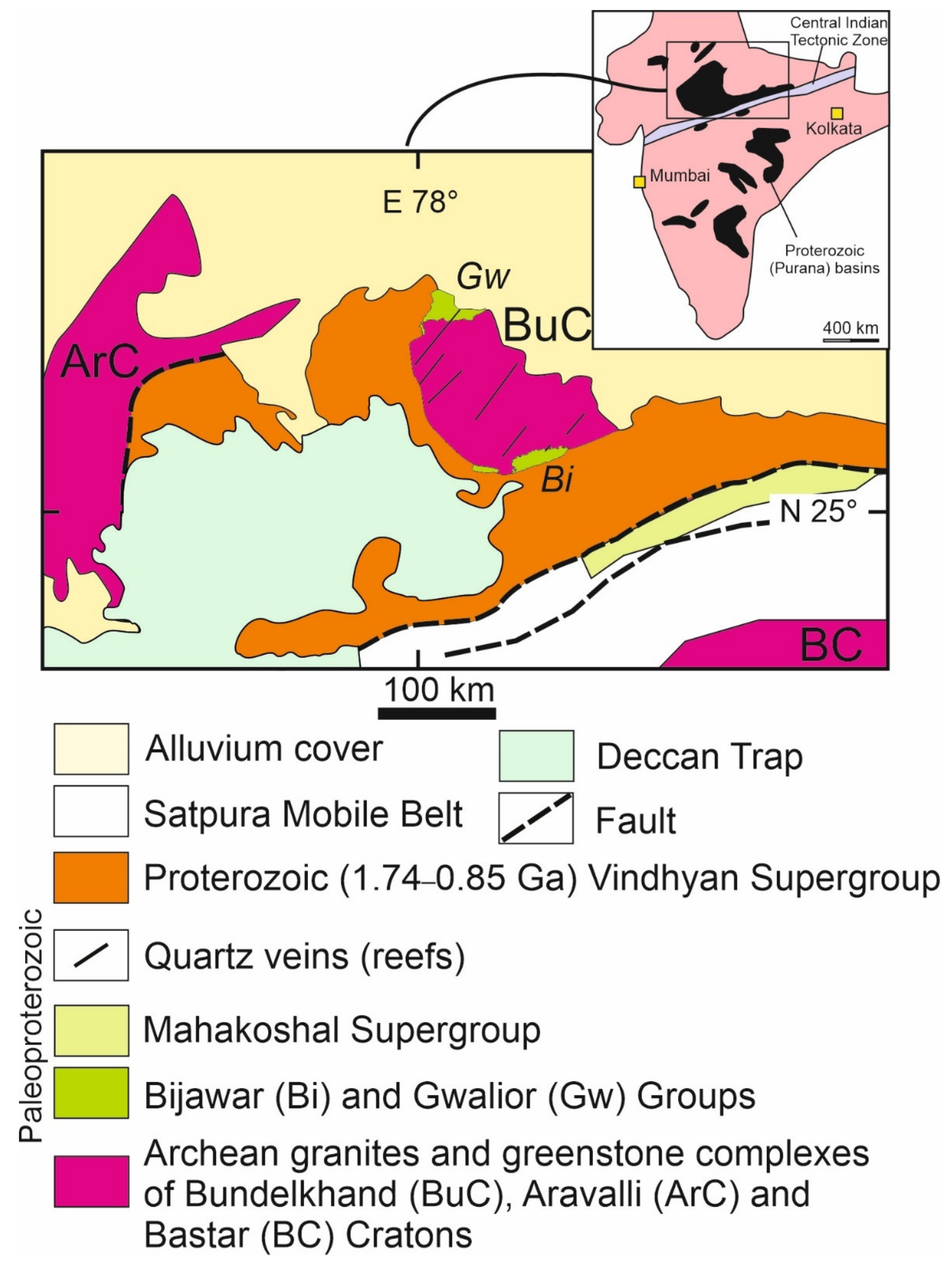

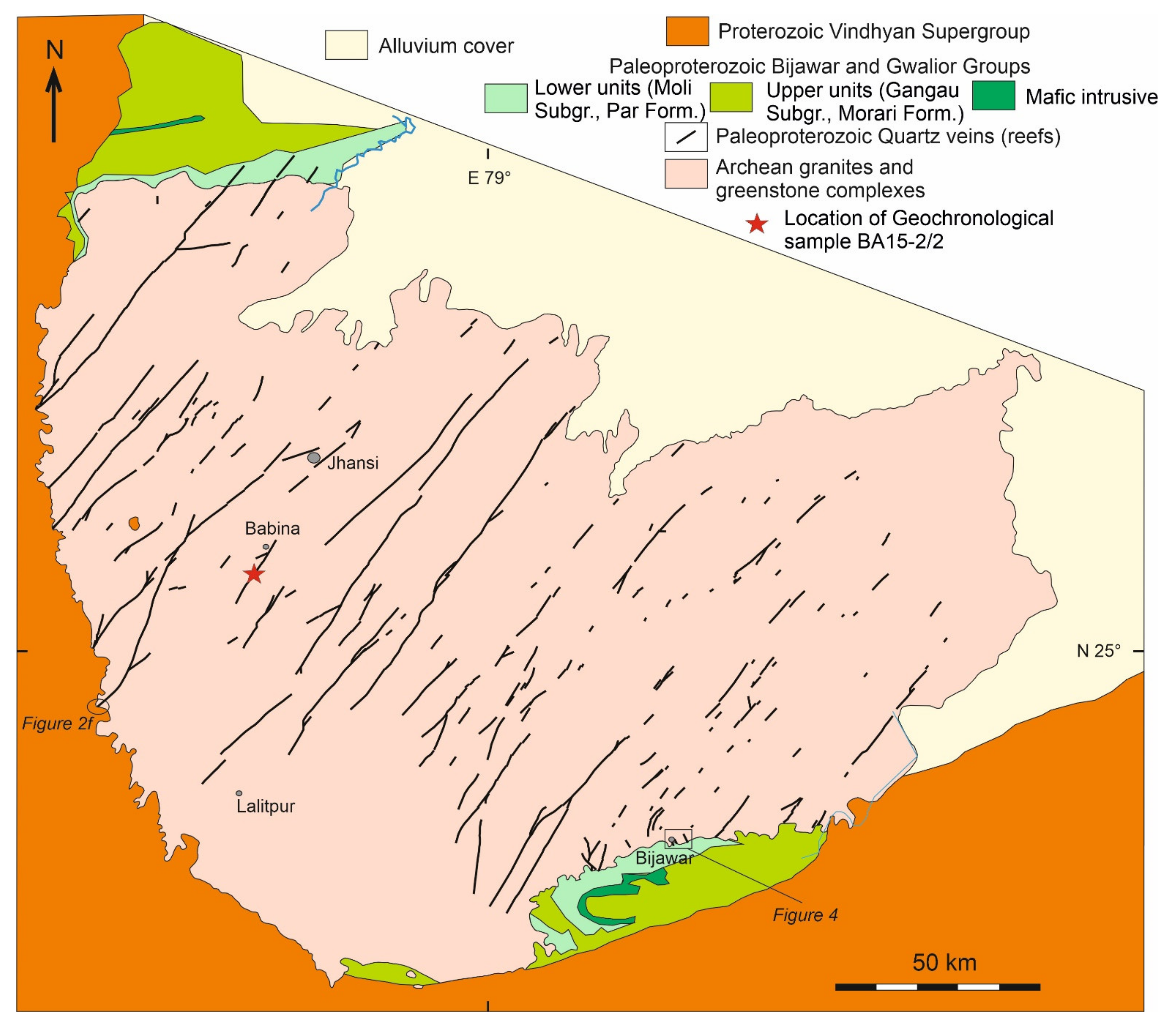

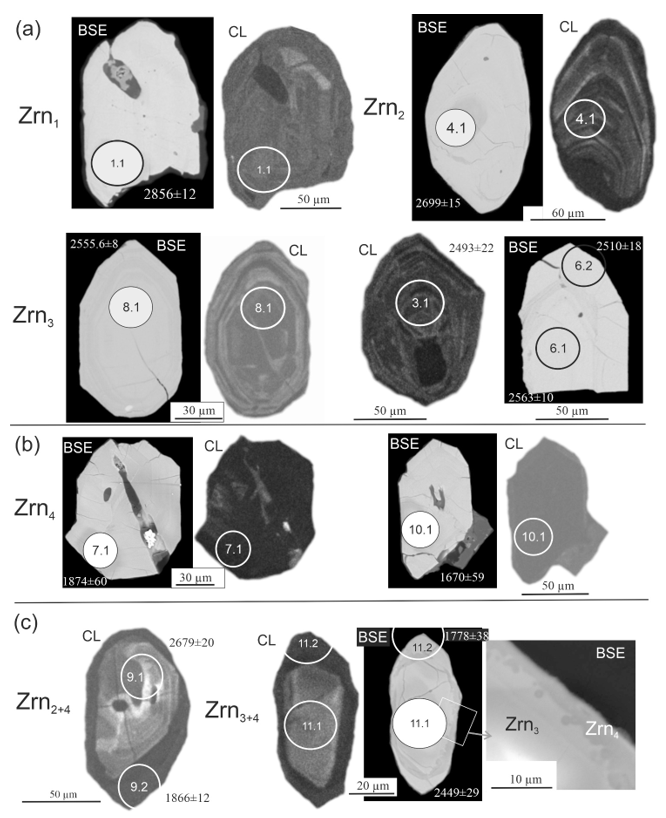
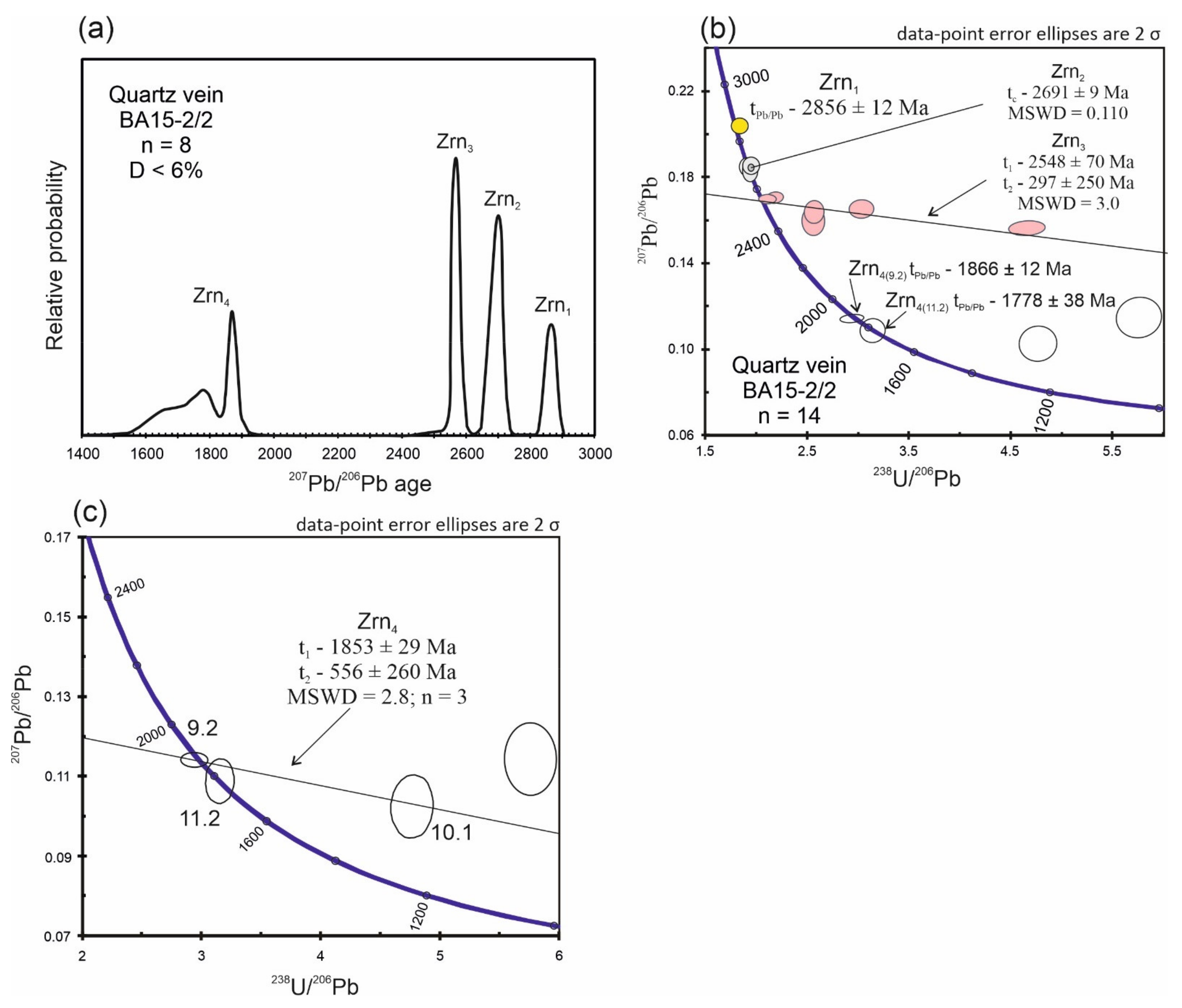
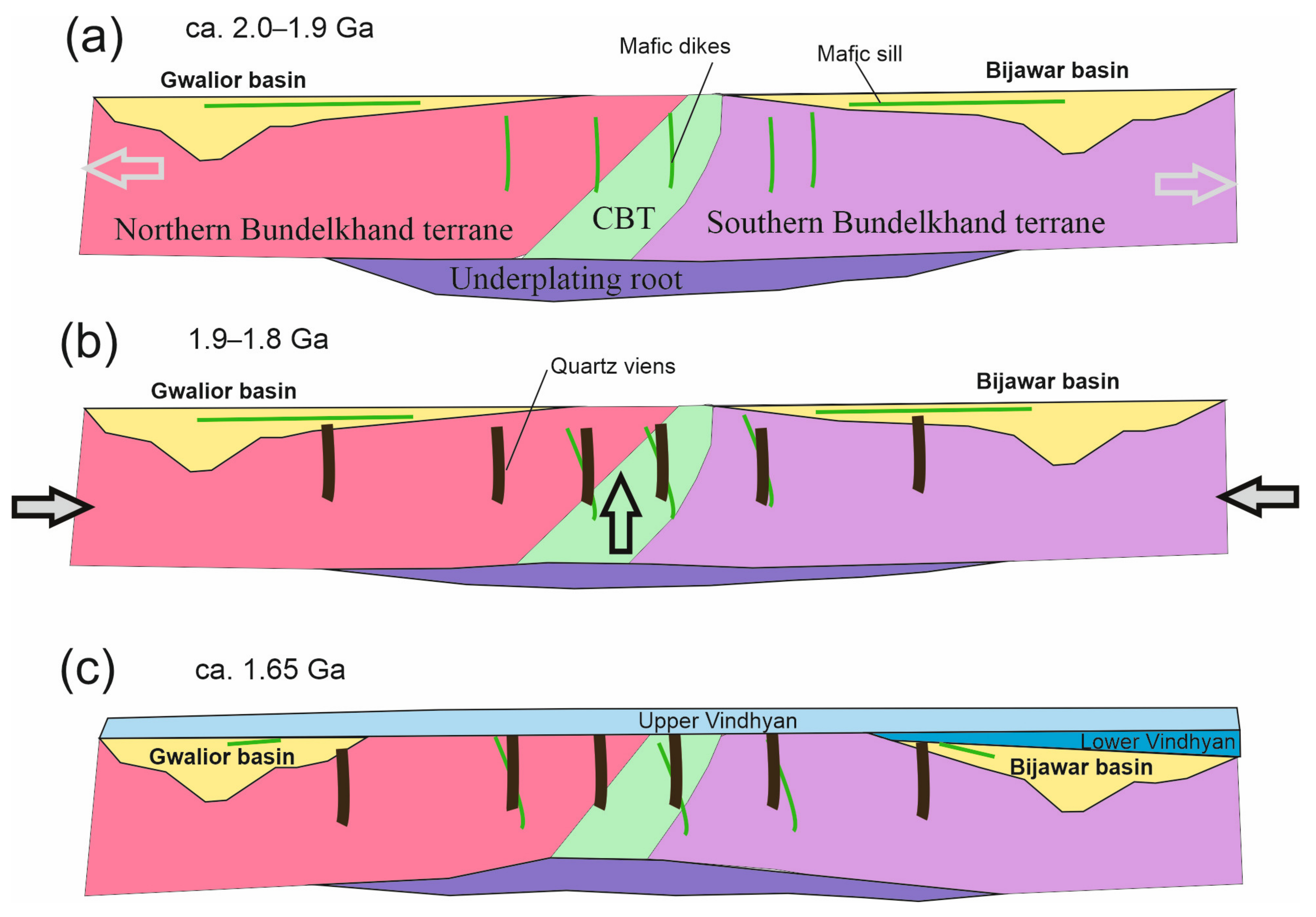
| Spot | 206Pbc, % | U, ppm | Th, ppm | 232Th/ 238U | 206Pb*, ppm | Age, Ma (±1σ) | D, % | 207Pb*/ 235U | ±1σ, % | 206Pb*/ 238U | ±1σ, % | 238U/ 206Pb* | ±1σ, % | 207Pb*/ 206Pb* | ±1σ, % | Rho | |
|---|---|---|---|---|---|---|---|---|---|---|---|---|---|---|---|---|---|
| 206Pb/238U | 207Pb/206Pb | ||||||||||||||||
| 10.1 | 3.90 | 1478 | 442 | 0.31 | 279 | 1227 ± 17 | 1670 ± 59 | 36 | 4.734 | 1.6 | 0.1025 | 3.2 | 2.96 | 3.6 | 0.2097 | 1.6 | 0.438 |
| 11.2 | 1.21 | 897 | 39 | 0.05 | 248 | 1777 ± 25 | 1778 ± 38 | 0 | 3.143 | 1.6 | 0.1087 | 2.1 | 4.76 | 2.6 | 0.3174 | 1.6 | 0.615 |
| 9.2 | 0.10 | 699 | 15 | 0.02 | 204 | 1885 ± 26 | 1866 ± 12 | −1 | 2.944 | 1.6 | 0.1141 | 0.6 | 5.35 | 1.7 | 0.3397 | 1.6 | 0.925 |
| 7.1 | 10.74 | 1193 | 442 | 0.38 | 205 | 1032 ± 15 | 1874 ± 60 | 82 | 5.611 | 1.6 | 0.1147 | 3.4 | 2.74 | 3.7 | 0.1736 | 1.6 | 0.435 |
| 2.1 | 1.01 | 542 | 166 | 0.32 | 101 | 1252 ± 18 | 2416 ± 16 | 93 | 4.651 | 1.6 | 0.1563 | 0.9 | 4.62 | 1.8 | 0.2143 | 1.6 | 0.865 |
| 11.1 | 0.63 | 113 | 65 | 0.59 | 38.3 | 2124 ± 35 | 2449 ± 29 | 15 | 2.557 | 1.9 | 0.1594 | 1.7 | 8.58 | 2.6 | 0.3903 | 1.9 | 0.743 |
| 3.1 | 2.98 | 406 | 414 | 1.05 | 141 | 2119 ± 29 | 2493 ± 22 | 18 | 2.544 | 1.6 | 0.1636 | 1.3 | 8.78 | 2.1 | 0.3892 | 1.6 | 0.768 |
| 6.2 | 0.86 | 423 | 238 | 0.58 | 121 | 1834 ± 26 | 2510 ± 18 | 37 | 3.03 | 1.6 | 0.1652 | 1.1 | 7.50 | 1.9 | 0.3291 | 1.6 | 0.827 |
| 8.1 | 0.02 | 366 | 247 | 0.70 | 148 | 2493 ± 33 | 2556 ± 8 | 3 | 2.118 | 1.6 | 0.1698 | 0.5 | 11.05 | 1.7 | 0.4721 | 1.6 | 0.956 |
| 6.1 | 0.19 | 294 | 207 | 0.73 | 116 | 2429 ± 32 | 2563 ± 10 | 6 | 2.184 | 1.6 | 0.1705 | 0.6 | 10.76 | 1.7 | 0.4576 | 1.6 | 0.933 |
| 9.1 | 0.00 | 120 | 48 | 0.41 | 53.1 | 2680 ± 38 | 2679 ± 20 | 0 | 1.94 | 1.7 | 0.1829 | 1.2 | 13.00 | 2.1 | 0.5154 | 1.7 | 0.824 |
| 5.1 | 0.10 | 108 | 35 | 0.33 | 48.6 | 2710 ± 39 | 2694 ± 16 | −1 | 1.913 | 1.7 | 0.1845 | 1.0 | 13.30 | 2 | 0.5226 | 1.7 | 0.879 |
| 4.1 | 0.04 | 238 | 182 | 0.79 | 104 | 2662 ± 36 | 2699 ± 15 | 1 | 1.956 | 1.7 | 0.1851 | 0.9 | 13.05 | 1.9 | 0.5113 | 1.7 | 0.875 |
| 1.1 | 0.05 | 130 | 83 | 0.66 | 60.8 | 2798 ± 40 | 2856 ± 12 | 2 | 1.839 | 1.7 | 0.2037 | 0.7 | 15.27 | 1.9 | 0.5436 | 1.7 | 0.926 |
Publisher’s Note: MDPI stays neutral with regard to jurisdictional claims in published maps and institutional affiliations. |
© 2022 by the authors. Licensee MDPI, Basel, Switzerland. This article is an open access article distributed under the terms and conditions of the Creative Commons Attribution (CC BY) license (https://creativecommons.org/licenses/by/4.0/).
Share and Cite
Slabunov, A.I.; Singh, V.K. Giant Quartz Veins of the Bundelkhand Craton, Indian Shield: New Geological Data and U-Th-Pb Age. Minerals 2022, 12, 168. https://doi.org/10.3390/min12020168
Slabunov AI, Singh VK. Giant Quartz Veins of the Bundelkhand Craton, Indian Shield: New Geological Data and U-Th-Pb Age. Minerals. 2022; 12(2):168. https://doi.org/10.3390/min12020168
Chicago/Turabian StyleSlabunov, Alexander I., and Vinod K. Singh. 2022. "Giant Quartz Veins of the Bundelkhand Craton, Indian Shield: New Geological Data and U-Th-Pb Age" Minerals 12, no. 2: 168. https://doi.org/10.3390/min12020168
APA StyleSlabunov, A. I., & Singh, V. K. (2022). Giant Quartz Veins of the Bundelkhand Craton, Indian Shield: New Geological Data and U-Th-Pb Age. Minerals, 12(2), 168. https://doi.org/10.3390/min12020168







